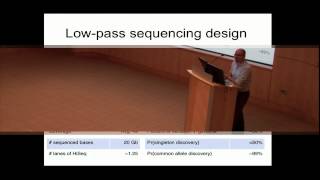Saturday, 20 December, 2025г.
















Где искать: по сайтам Запорожской области, статьи, видео ролики
пример: покупка автомобиля в Запорожье
ASHG 2010 Mtg.: "Discovery of a Gene for Kabuki Syndrome by Exome Sequencing" (Mark Hannibal)
TO VIEW THE FULL WEBCAST OF THIS SESSION, GO TO:
http://www.ashg.org/2010meeting/video/vlogin.shtml
ASHG 2010 Annual Meeting Plenary Session: "Discovery of a Gene for Kabuki Syndrome by Exome Sequencing and Genotype-Phenotype Relationship in 110 Cases"
Speaker: Dr. Mark Hannibal, University of Washington, Seattle
November 3, 2010 (Washington, DC)
DESCRIPTION: Kabuki syndrome is a rare, multiple malformation disorder characterized by a distinctive facial appearance, cardiac anomalies, skeletal abnormalities, and mild to severe mental retardation. Simplex cases make up the vast majority of the 400 or so reported cases with Kabuki syndrome, but parent-to-child transmission in more than a half-dozen instances suggests that it is an autosomal dominant disorder. The relatively low number of cases, the lack of multiplex families and the phenotypic variability of Kabuki syndrome have made the identification of the gene(s) underlying Kabuki syndrome intractable to conventional approaches of gene discovery, despite aggressive efforts. We sequenced the exomes of ten unrelated individuals with Kabuki syndrome and discovered that nine of the ten of them had mutations in a gene that encodes a Trithorax-group histone methyltransferase, a protein which is important in the epigenetic control of active chromatin states. Subsequent screening of an additional 100 families with Kabuki syndrome identified mutations in ~60%. This result is compelling evidence that Kabuki syndrome is genetically heterogeneous. In about one-third of the simplex cases, DNA was available from both parents and mutations were confirmed to be de novo events in these cases. The majority of variants found to cause Kabuki syndrome were novel nonsense or frameshift mutations that are predicted to result in haploinsufficiency. Comparison of the clinical characteristics of mutation-negative and mutation-positive cases allowed us to explore both the relationship between genotype and phenotype and the phenotype of mutation-negative cases. These are important steps toward more accurate predictions about the natural history of individual cases/families as well as for identifying additional genes for Kabuki syndrome.
Теги:
ASHG ASHG 2010 Mark Hannibal human genetics genetic genetics genome genomics genetic research genetics research science scientific research research Kabuki Syndrome DNA exome exomes exome sequencing genome sequence genome sequencing gene sequencing genetic sequencing mendelian disorder genotype phenotype disease genes dysmorphology genetic disease gene disorder genetic disorder gene mutation
Похожие видео
Мой аккаунт


 У вашего броузера проблема в совместимости с HTML5
У вашего броузера проблема в совместимости с HTML5


